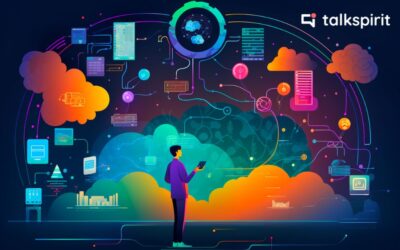Looking to reign in your IT budget? Guide the growth of your company? Modernize your information systems? Implement new working methods and tools?
Whatever your goals, one thing is certain: the 10 tech trends identified by Gartner for 2023 should help guide your strategy—and help you remain innovative and resilient.
Here’s a wrap up of all the 2023 tech trends all CIOs need to know about:
1. The digital immune system
Like our own immune system, the digital immune system aims to improve the resilience of organizations’ products, services, and information systems by combining various technologies and practices from:
- artificial intelligence (AI)
- observability (the ability to measure the internal state of a system by observing what it produces as output)
- chaos engineering (a methodology of testing a computer system’s resilience through created disruptive events)
- self-healing (the ability of software or infrastructure to repair itself autonomously)
- the software supply chain
- site reliability engineering (SRE, or using software to manage systems, troubleshoot problems, and automate infrastructure and operational tasks)

According to Gartner, organizations that invest in the implementation of a digital immune system will be able to reduce their system downtime by 80% by 2025, thereby improving customer satisfaction. American Airlines is following this trend by implementing a digital immune system to identify potential vulnerabilities throughout its operations.
2. Applied observability
Applied observability is also among the top tech trends to watch in 2023. It involves leveraging observable data (like wait times, downloads, API calls, or file transfers) to make faster and more accurate decisions.
This is what the car manufacturer Tesla uses to measure the driving behavior of its customers and assign them a safety index which—depending on the score given—raises or lowers their insurance premiums.
This is an example that other companies should soon follow. By 2026, 70% of organizations that succeed in using applied observability should accelerate their decision-making processes. This could give them a competitive advantage in certain IT or business processes.
3. AI TRiSM: AI trust, risk, and security management
AI TRiSM (for AI trust, risk, and security management), is now essential to ensure the reliability, robustness, and safety of AI models and thus better manage the associated risks.
This risk management is based in particular on methods used for:
- the interpretability and explicability of models (making it possible to understand how a model works and explain why it works this way)
- AI confidentiality
- ModelOps (which consists of creating analytical models that can be quickly put into production)
- resistance to adverse attacks

Case in point: Danish startup Abzu recently created an AI model that draws on these different methods to generate explainable patterns that identify cause-and-effect relationships. This allows it to validate results more easily—and hopefully in the long haul—develop better breast cancer drugs.
According to Gartner, organizations that can keep up with this trend are expected to see a 50 percent increase in the results of their AI models by 2026, especially in terms of adoption and achievement of business goals.
4. Industry cloud platforms
By 2027, Gartner predicts that more than 50% of enterprises will use industry cloud platforms to accelerate their business initiatives.
These platforms enable the combination of three cloud computing models: IaaS (infrastructure as a service), PaaS (platform as a service), and SaaS (software as a service).

Unlike traditional cloud platforms, industry cloud platforms are highly customizable. This means they can easily adapt to the needs of different industries, enabling organizations to gain agility and innovate faster.
In Hangzhou, a large city in southeastern China, an industry-wide cloud platform was created to mitigate traffic congestion by combining digital infrastructure, a data management platform and numerous applications. As a result, Hangzhou, once recognized as the fifth most polluted city in China, has left the list of China’s top 50 most polluted cities.
5. Platform engineering
Platform engineering is also one of the top tech trends for 2023. By 2026, Gartner predicts that 80% of software engineering organizations will have platform teams that bring together all the services, components, and tools regularly used to build apps.
Several forward-thinking organizations have already started to create such platforms to facilitate and accelerate the work of developers, as well as improve the user experience.

For example, Nike has created composable applications that bring together strategic business capabilities that are deployed through modular technologies using APIs. This allows the company to adapt more easily to change, launch new products more quickly, and lower operating costs.
6. Wireless solutions
Wireless solutions—4G, 5G, LTE (long-term evolution), BLE (low-power Bluetooth), and Wi-Fi (5, 6, and now 7!)—are also expected to ramp up this year. By 2025, 60 percent of businesses will be using at least five wireless technologies simultaneously.
According to Gartner, these multiple wireless solutions will enable access to more data through integrated analytics and low-power systems that draw power from the network. This will enable wireless networks to directly drive business value.
Many companies have already positioned themselves on this trend. For example, the BSH Group (Bosch Siemens Hausgeräte) uses ultrasonic sensors to slow down the speed of its forklifts in real time. This investment has resulted in a 98% reduction in near misses and a 10% increase in productivity.
7. Super apps
A super app is an all-in-one application that integrates a set of standard features, as well as several independent mini applications. Each user can activate the applications of his choice, making super apps fully customizable.

Some of the existing super apps include:
- Revolut: the financial application to manage your money with ease
- PayPay: the electronic wallet that simplifies all your mobile payments
- Talkspirit: the all-in-one platform to streamline your internal communication, engage your community and facilitate teamwork
By 2027, more than 50% of the world’s population will be simultaneously using multiple super apps every day, Gartner estimates. So, if you haven’t yet embraced these all-in-one apps, it’s time to jump in!
8. Adaptive AI
The main added value of artificial intelligence (AI) today lies in its ability to develop and adapt to different environments. This ability is found in particular in adaptive AI systems.
These systems allow AI models to continuously train and learn new behavioral patterns post-deployment, so they can quickly adapt to changes and contingencies that may occur in the real world.
As a result, adaptive AI can generate value faster and keep AI models aligned with business goals. Not surprisingly, we learn that companies that know how to create and manage adaptive AI systems will outperform their peers by 25% when operationalizing AI models.
US chemical manufacturer Dow, among other global companies, have deployed these adaptive AI systems to obtain advanced analytics and optimize profitability. In fact, their analytics platform has increased in value by an estimated 320%!
9. The metaverse
Chances are you’ve already heard about it. We’re talking about the metaverse: this immersive virtual world that offers a wide range of possibilities—one of the biggest tech trends of 2023. It can be used to recruit, train, participate in a professional event, create a store, invest, or simply work as a team.
In the era of remote work and hybrid work, the metaverse is a good way to develop employee engagement, create links, and facilitate remote team collaboration.
Siemens and NVIDIA, for example, have created an industrial metaverse where their customers can collaborate and brainstorm innovative solutions, as well as solve problems using the IoT (Internet of Things) and real-time analytics.
10. Sustainable technologies
This latest technological trend is perfectly aligned with current environmental issues. It involves the development of sustainable technologies: digital solutions that meet environmental, social, and/or governance criteria.

The goal of these technologies is to optimize the energy and environmental efficiency of our IT services and help consumers adopt more responsible practices.
Ultimately, this too will have a positive impact on companies’ overall performance, and its ability to attract and retain talent. By 2025, 50% of business leaders are expected to integrate the notion of sustainability into their performance indicators.
Examples of sustainable technologies and initiatives include:
- the robots Apple uses to recycle its own products
- IKEA’s shared guide for creating and promoting circular products
- the carbon footprint measurement tool of the Spanish bank BBVA
- the employee engagement platform Timberland uses to encourage its employees to participate in environmental and social initiatives
*
* *
With these 10 tech trends, you can now build or evolve your IT strategy for 2023. Of course, the trends presented in this article are not exhaustive, and they don’t include all the challenges that CIOs may face this year.
To explore more, we invite you to download our white paper, “CIOs: Navigating the New Challenges of Hybrid Work,” in which you will find many tips and testimonials from CIOs to meet all your technological challenges.



